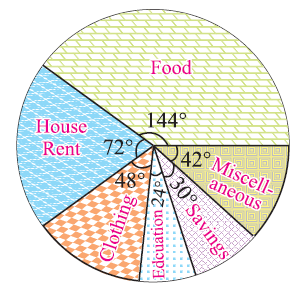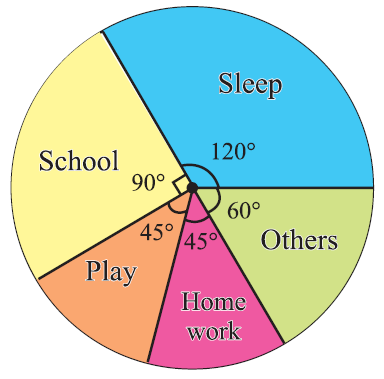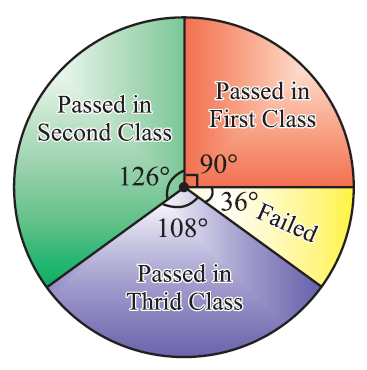DRAWING PIE CHART
Subscribe to our ▶️ YouTube channel 🔴 for the latest videos, updates, and tips.
Here, we take a circle and the whole circle is divided into sectors. The size of each sector is proportional to the activity or information it represents.
Since, the sectors resemble the slices of a pie, it is called a pie chart.
Construction of pie chart - Important note
In a pie chart, the various observations or components are represented by the sectors of a circle and the whole circle represents the sum of the value of all the components .Clearly, the total angle of 360° at the center of the circle is divided according to the values of the components .
The central angle of a component is
= [ Value of the component / Total value] x 360°
Sometimes, the value of the components are expressed in percentages. In such cases,
The central angle of a component is
= [ Percentage value of the component / 100 ] x 360°
Steps for construction of pie chart
Step 1 :
Calculate the central angle for each component , using the above formula.
Step 2 :
Draw a circle of convenient radius.
Step 3 :
Within this circle, draw a horizontal radius.
Step 4 :
Draw radius making central angle of first component with horizontal radius; this sector represents the first component. From this radius, draw next radius with central angle of second component; this sector represents second component and so on, until we exhaust all components.
Step 5 :
Shade each sector differently and mark the component it represents.
Step 6 :
Give the heading for each component.
Construction of pie chart - Examples
Example 1 :
The following table shows the half yearly budget of a family
|
Particulars Food House rent Clothing Education Savings Miscellaneous |
Expenses (in $) 4800 2400 1600 800 1000 1400 |
Draw a pie chart to represent the above information.
Solution :
The central angle of a component is
= [ Value of the component / Total value] x 360°
We may calculate the central angles for various components as follows :
|
Particulars Food House rent Clothing Education Savings Miscellaneous ------------ Total |
Expenses 4800 2400 1600 800 1000 1400 ---------- 12000 |
Central angle (4800/12000) ⋅ 360 = 144° (2400/12000) ⋅ 360 = 72° (1600/12000) ⋅ 360 = 48° (800/12000) ⋅ 360 = 24° (1000/12000) ⋅ 360 = 30° (1400/12000) ⋅ 360 = 42° |
From the above table, clearly, we obtain the required pie chart as shown below.

Example 2 :
The number of hours spent by a school student on various activities on a working day, is given below. Construct a pie chart using the angle measurement.
|
Activity Sleep School Play Homework Others |
Number of hours 8 6 3 3 4 |
Draw a pie chart to represent the above information.
Solution :
The central angle of a component is
= [ Value of the component / Total value] x 360°
We may calculate the central angles for various components as follows :
|
Activity Sleep School Play Homework Others ----------- Total |
Duration in hours 8 6 3 3 4 ---------- 24 |
Central angle (8/24) ⋅ 360 = 120° (6/24) ⋅ 360 = 90° (3/24) ⋅ 360 = 45° (3/24) ⋅ 360 = 45° (4/24) ⋅ 360 = 60° 360° |
From the above table, clearly, we obtain the required pie chart as shown below.

Example 3 :
The result of an examination of a school is as follows :
|
Result Passed in first class Passed in second class Passed in third class Failed |
Percentage of students 25% 35% 30% 10% |
Draw a pie chart to represent the above information.
Solution :
The central angle of a component is
= [ Value of the component / 100 ] x 360°
We may calculate the central angles for various components as follows :
|
Result Passed in first class Passed in second class Passed in third class Failed ---------- Total |
Percentage of students 25% 35% 30% 10% ----------- 100% |
Central angle (25/100) ⋅ 360 = 90° (35/100) ⋅ 360 = 126° (30/100) ⋅ 360 = 108° (10/100) ⋅ 360 = 36° ------------- 360° |
From the above table, clearly, we obtain the required pie chart as shown below.

Subscribe to our ▶️ YouTube channel 🔴 for the latest videos, updates, and tips.
Kindly mail your feedback to v4formath@gmail.com
We always appreciate your feedback.
About Us | Contact Us | Privacy Policy
©All rights reserved. onlinemath4all.com
Recent Articles
-
AP Calculus BC Problems with Solutions
Dec 20, 25 10:51 AM
AP Calculus BC Problems with Solutions -
AP Precalculus Problems and Solutions (Part - 1)
Dec 20, 25 10:49 AM
AP Precalculus Problems and Solutions (Part - 1) -
AP Calculus AB Problems with Solutions (Part - 1)
Dec 20, 25 10:49 AM
AP Calculus AB Problems with Solutions (Part - 1)
